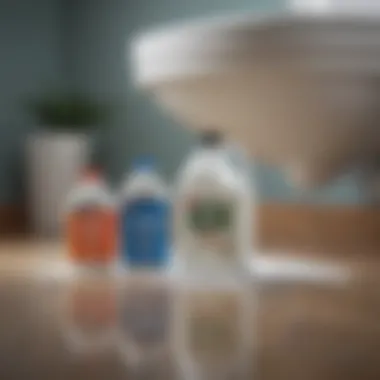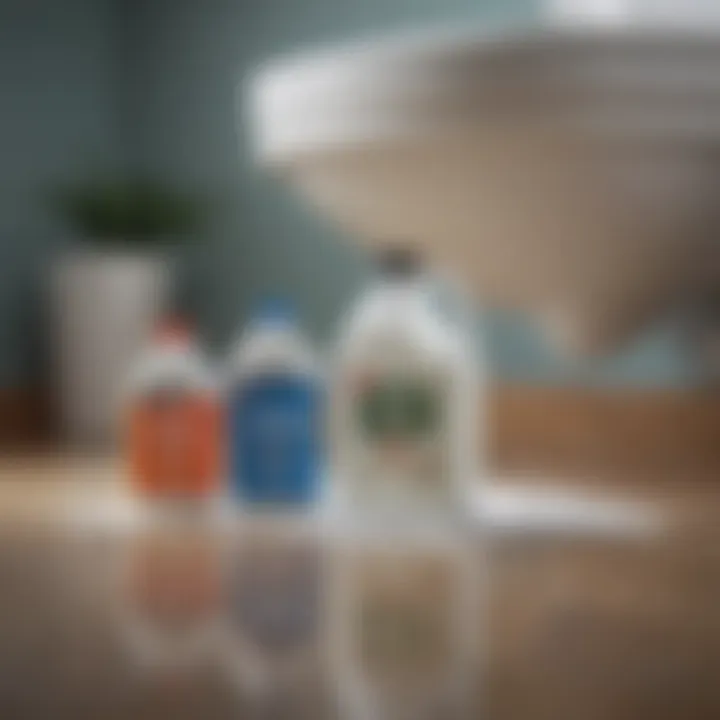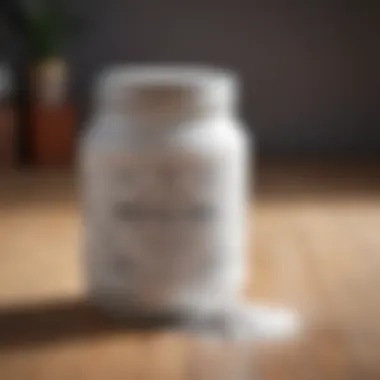Unclogging a Toilet with Baking Soda: A Practical Guide


Intro
Unclogging a toilet is a common household issue, and many homeowners seek practical solutions that do not rely on harsh chemicals. Baking soda, a natural and eco-friendly option, proves to be effective in addressing this problem. This guide outlines the process of using baking soda to unclog toilets, the scientific rationale behind its effectiveness, and preventive measures for maintaining toilet hygiene.
Understanding how baking soda interacts with other substances is crucial. When combined with vinegar, it creates a chemical reaction that can help break down blockages. This guide will provide step-by-step instructions to ensure a successful unclogging experience, along with additional maintenance tips to keep your toilet functioning optimally.
The Science Behind Baking Soda
Baking soda, or sodium bicarbonate, is an alkaline compound. In the presence of an acid, such as vinegar, it produces carbon dioxide gas. This gas helps break up clogs and push waste through the pipes. Its effectiveness depends on the nature of the clog. Simple clogs caused by organic materials respond well to this method.
How It Works
- When baking soda is poured into the toilet bowl, it begins to dissolve in water, releasing its alkaline properties.
- Following this, vinegar is added, which reacts to form bubbles.
- This bubbling action creates pressure that can dislodge tough clogs, making it easier for water to flow.
It is essential to ensure that the mixture is not forced into the pipes too quickly, as this can lead to ineffective results.
Step-by-Step Unclogging Process
- Gather Your Materials: You will need baking soda, vinegar, and hot water. Optionally, a plunger might help if the clog is particularly stubborn.
- Prepare the Toilet Bowl: If the water level is too high, remove some with a bucket to avoid overflow.
- Add Baking Soda: Pour about one cup of baking soda into the toilet bowl, ensuring it is evenly distributed.
- Add Vinegar: Follow with one to two cups of vinegar. The bubbling will start right away.
- Wait: Allow the mixture to sit for about 30 minutes. This waiting period lets the chemicals do their work.
- Flush: After 30 minutes, flush the toilet. Observe if the water drains properly.
- Repeat if Necessary: For persistent clogs, repeat the process or consider using a plunger if the clog remains.
Additional Maintenance Tips
To prevent future clogs and maintain toilet hygiene, consider the following strategies:
- Be Mindful of Waste: Only human waste and toilet paper should go into the toilet. Other items should be disposed of properly.
- Regular Cleaning: Use a mixture of baking soda and vinegar for regular toilet cleaning. This can help prevent mineral buildup over time.
- Check for Leaks: Regularly inspect the toilet for any leaks or issues that may lead to clogs.
- Educate Household Members: Ensure everyone in the household understands what should and should not be flushed.
"Using baking soda to unclog a toilet is not just effective; it is also safe for plumbing and the environment."
By following these methods, homeowners can effectively manage toilet clogs while promoting a healthier living environment. This guide underscores the practicality of natural solutions in everyday home maintenance.
Understanding Toilet Clogs
Understanding toilet clogs is fundamental when addressing plumbing issues in households. This section provides insight into the various types of clogs and their causes, enabling homeowners to tackle the problem effectively. It emphasizes that by grasping the nature of clogs, one can select the most appropriate unclogging method, including the use of baking soda. This understanding also aids in preventing future clogs. Taking the time to learn about toilet clogs can save substantial time and money, reducing reliance on professional services.
Types of Toilet Clogs
Understanding the different types of toilet clogs is essential for effective resolution.
Minor clogs
Minor clogs typically refer to situations where water drains slowly but does not completely back up. They are often characterized by gurgling sounds or gradual drain delays. Commonly resulting from excessive toilet paper use, minor clogs are usually manageable with simple methods like using baking soda. Using these methods can often avoid escalating the situation to something more severe.
These clogs are beneficial from a maintenance perspective. They let users recognize signs of the issue without immediate panic. Responding to minor clogs early on can prevent the need for more drastic measures, making them popular in many households. A unique feature of minor clogs is that they can often resolve with techniques that do not involve harsh chemicals or specialized tools.
Severe clogs
Severe clogs arise when the toilet backing up completely stops any water flow. This situation is typically more urgent, frequently caused by blockages due to foreign objects or a build-up of waste that is too substantial for standard drainage. These clogs often require more intense efforts to resolve.
The key characteristic of severe clogs is their potential to significantly impact everyday life. Unlike minor clogs, they demand immediate attention to restore functionality. Although challenging, tackling these clogs proactively can educate homeowners on their plumbing system. A unique disadvantage of severe clogs is that they often necessitate professional assistance, leading to increased costs if resolved improperly.
Foreign object obstructions
Foreign object obstructions occur when solid items accidentally enter the toilet and block the passage. Common objects include toys, wipes, or even personal items. Recognizing this type of clog is crucial for deciding whether you can address it yourself or if professional help is needed.
The primary characteristic of foreign object obstructions is their complexity. They do not typically resolve through typical unclogging methods, such as using baking soda. This makes them less favorable in this guide, as effective resolution often requires a physical removal.
While they can be more difficult to manage, understanding how foreign object obstructions occur helps prevent them. An essential advantage is that improving awareness about what not to flush can help reduce occurrences of such blockages, thus contributing to a more effective toilet maintenance strategy.


Causes of Toilet Clogs
Understanding the causes of toilet clogs is just as crucial as understanding their types. Recognizing why clogs happen can help homeowners make informed decisions about prevention and maintenance.
Excessive toilet paper use
Excessive toilet paper use is one of the most common contributors to toilet clogs. Using large amounts can surpass what the plumbing can handle, leading to blockages. Limited plumbing design in older systems makes them particularly susceptible.
The key trait of excessive use is that it is fully within personal control. This makes it an easily avoidable cause of clogs. Being cautious with how much toilet paper is used can significantly reduce clogging risk. An added benefit of reducing toilet paper use is the reduced likelihood of needing to use methods like baking soda, ensuring a smooth plumbing operation.
Non-flushable items
Non-flushable items cause clogs by adding materials that plumbing systems are not designed to handle. Examples include feminine hygiene products, wipes that claim to be flushable, and cotton balls. Understanding that such items do not dissolve or disintegrate in water is key.
This cause highlights the importance of awareness and education. It is a significant topic for this article as avoiding these items can greatly minimize the chance of clogs. Educating household members about proper disposal can lead to better maintenance of the plumbing systems, preventing unnecessary clogs.
Accumulated waste
Accumulated waste occurs when excess debris builds up in pipes over time. This gradual process can eventually lead to clogs that obstruct flow entirely. It is often the result of frequent flushing of inappropriate items or lack of regular cleaning.
The vital aspect of accumulated waste is that it develops slowly, which can make it easy to overlook until a significant issue arises. Recognizing this problem early can greatly help in the unclogging process, as proper maintenance can assist in avoiding buildup. The necessity of establishing a regular maintenance schedule becomes apparent, thus assisting in overall toilet hygiene.
The Role of Baking Soda in Unclogging
Baking soda significantly aids in the unclogging process of toilets due to its chemical properties and several effective applications. This common household substance serves as a natural alternative to harsh chemicals, appealing especially to homeowners seeking eco-friendly solutions. The following sections will delve into the underlying science, benefits, and additional considerations surrounding the use of baking soda.
Chemical Properties of Baking Soda
Alkalinity
Alkalinity is a key chemical property of baking soda, which is sodium bicarbonate. This characteristic contributes positively to its unclogging capabilities. When in contact with water, baking soda raises the pH level. This can help neutralize acids present in clogs.
The ability of baking soda to react with acidic materials in clogs makes it a beneficial choice for those looking to avoid harmful chemicals. One unique feature of its alkalinity is that it can delicately break down tough residues without damaging piping systems. This makes it a consistent go-to for safe toilet maintenance.
Reaction with vinegar
The reaction between baking soda and vinegar is another significant aspect of its effectiveness. When combined, they produce a fizzing action due to the release of carbon dioxide gas. This reaction can create a bubbling action that aids in dislodging stubborn clogs.
This combination is popular because it is not only effective but also gentle on the plumbing. A potential disadvantage is that the reaction is temporary, meaning it requires precise timing and application for optimal results. However, when used correctly, the combined effects enhance the overall unclogging process.
Why Baking Soda is Effective
Gentle cleaning
The gentle cleaning properties of baking soda are crucial for maintaining not only cleanliness but also the integrity of plumbing systems. Unlike abrasive cleaners, baking soda does not scratch or damage surfaces. This key characteristic allows it to dissolve buildups without the risk of long-term harm to toilets.
This gentleness is particularly useful for routine maintenance, as it can be used frequently without adverse effects. One unique feature is that it can also be combined with other natural ingredients for a more profound cleaning effect. It is a beneficial and safe approach for homeowners looking to keep their toilets clean without chemical exposure.
Odor neutralization
Baking soda is widely recognized for its efficiency in neutralizing odors. This aspect greatly contributes to toilet hygiene. The fundamental characteristic lies in its ability to absorb and neutralize foul smells rather than merely masking them.
Considering its effective odor neutralization, it is a popular choice among homeowners who value cleanliness and a fresh-smelling bathroom. However, its disadvantage is that it might need to be reapplied regularly to sustain effects, especially in high-usage toilets. Its unique property of improving air quality in addition to cleaning makes it a dual-purpose solution for toilet maintenance.
Preparing for the Unclogging Process
Preparing for the unclogging process is a crucial step that lays the groundwork for successfully resolving toilet clogs. It involves gathering the necessary tools and ensuring safety throughout the process. By taking these precautions, you not only enhance your chances of effectively clearing the clog but also protect yourself and your environment during the procedure.


Essential Tools and Materials
Baking Soda
Baking soda is a key ingredient in the unclogging process. Its alkaline nature allows it to break down organic materials, making it effective against common clogs caused by waste or toilet paper accumulation. Moreover, baking soda is non-toxic and eco-friendly, appealing to those seeking natural solutions. Its unique feature lies in its ability to create a slight fizz when combined with other materials, facilitating the unclogging process. One of the main advantages of using baking soda is its low cost, and it can be sourced easily from local grocery stores. However, it may not be effective against more severe blockages that require stronger interventions.
Vinegar
Vinegar complements baking soda well in unclogging toilets. Its acidic properties allow it to dissolve mineral deposits and other clogs that baking soda might not clear alone. This makes it a popular choice for this process. The reaction between vinegar and baking soda generates carbon dioxide gas, which helps lift clogs. One advantage of vinegar is its availability; it is commonly found in kitchens. However, the strong aroma of vinegar can be a downside for some users.
Hot Water
Hot water plays a vital role during the unclogging process. It aids in dissolving more stubborn materials and can help improve the efficacy of baking soda and vinegar. The heat from hot water can melt away buildup that may not be broken down easily otherwise. This unique characteristic makes hot water a popular addition to the unclogging procedure. However, caution is needed as water that is too hot can damage toilet components.
Safety Precautions
Protective Gear
Protective gear is essential to ensure your safety while unclogging a toilet. Wearing gloves and goggles can shield your skin and eyes from potential splashes of dirty water or chemical reactions. This precaution is particularly important when dealing with older plumbing systems that may release bacteria. Having this piece of equipment means better hygiene during the process. It might feel cumbersome, but the protection it offers is invaluable.
Ventilation
Ventilation is necessary when working with baking soda and vinegar. Proper airflow helps dissipate any strong odors and prevents the buildup of harmful gases released during the reaction. It is advisable to keep windows open or use fans to enhance airflow. This is a beneficial aspect of the process as it contributes to a safer working environment. Inadequate ventilation could lead to discomfort or even minor health effects, making it an important consideration.
Step-by-Step Guide to Unclogging
In this section, we will dive into the step-by-step guide to unclogging a toilet using baking soda. This method is straightforward and effective for many common clog scenarios. Understanding and following these steps can empower homeowners to address clogging issues without resorting to harsh chemicals.
The process is practical and environmentally friendly.
Initial Assessment
Check water level
Checking the water level in the toilet bowl is the first crucial step in assessing the situation. It indicates the presence of a clog and its severity. A low water level might suggest a minor obstruction, while a high water level indicates a more severe clog. This method is beneficial as it allows homeowners to gauge the next actions without unnecessary attempts.
This step is straightforward, yet it determines the success of the subsequent techniques. If the bowl is nearly empty, it may simply need more water. However, if the water is high, precautions are needed to avoid overflow during the unclogging process. Assessing the water level accurately contributes directly to effective toilet maintenance.
Evaluate clog severity
Once the water level is checked, evaluating the severity of the clog is essential. This involves observing how the toilet reacts when flushed. A toilet that drains slowly may indicate a minor clog, while one that does not drain at all suggests a significant obstruction.
This evaluation is a popular choice for many homeowners because it helps define the appropriate response. This unique aspect allows you to weigh the methods used for unclogging effectively. Understanding the clog’s severity can also help avoid unnecessary delays, enabling you to address the problem efficiently.
Application of Baking Soda
Pouring technique
The technique of pouring baking soda is central to the process. When pouring the baking soda, it is critical to do it evenly around the inside of the toilet bowl. This ensures even distribution, enhancing the chemical reactions needed to tackle the clog. The pouring technique is advantageous as it maximizes contact with the blockage.
Using the right technique can make it easier to break down the materials causing the obstruction. Homeowners who apply this technique will find it’s a simple yet effective approach to unclogging.
Waiting period
After applying the baking soda, a waiting period of about 10 to 15 minutes is recommended. During this time, the baking soda interacts with the clog, so patience is essential. This waiting period is an important part, as it allows the baking soda to do its work before further steps are taken. The effectiveness is rooted in the time given to let the reaction occur thoroughly. Those who neglect this time might find the unclogging efforts to be less effective.
Adding Vinegar and Hot Water
Combination effects
Adding vinegar after the baking soda introduces a powerful combination that can produce a fizzing reaction. This reaction helps to break down the debris in the toilet and can significantly improve the unclogging process. The combination of these two ingredients is well known for its effectiveness in tackling clogs. Many homeowners find this combination memorable and often return to it as an effective solution.
The synergistic effects of baking soda and vinegar illustrate why this method is frequently recommended in home maintenance discussions.
Timing and temperature
When adding hot water, timing and temperature are crucial. Use water that is hot but not boiling, as boiling water can damage the toilet's porcelain. The key here is to pour the hot water after the baking soda and vinegar. This step activates the ingredients further, ensuring they can reach areas that the baking soda alone may not. Proper timing ensures that each ingredient does its job without overpowering the others.


Flush and Evaluate
Observing results
Once you have added the vinegar and hot water, the final step is observing the results. Test the flushing to see if the water drains more effectively. This observation phase is vital in understanding how well the unclogging method has worked. Without this, one cannot ascertain the success of the process. It allows homeowners to determine swiftly if the methods applied were effective.
Determining if additional steps are needed
If the toilet remains clogged after observing the results, it’s vital to determine if additional steps are necessary. This could involve repeating the baking soda and vinegar process or even considering a physical method, such as a plunger. Recognizing this necessity early can save time and prevent potential overflow issues. The capacity to evaluate effectively keeps the maintenance process efficient and manageable.
Maintenance and Prevention Strategies
Maintaining a toilet involves more than just immediate fixes; it's essential to implement proactive strategies to prevent future clogs. Effective maintenance not only prolongs the life of your toilet but also enhances its efficiency. Regular checks and cleaning can help catch potential issues before they escalate. Moreover, implementing preventive measures ensures a cleaner bathroom environment, which benefits overall hygiene.
Regular Cleaning Practices
Frequency of cleaning
The frequency of cleaning is crucial for maintaining a toilet’s functionality. Generally, cleaning the toilet every week is advisable. Regular cleaning prevents the build-up of waste and mineral deposits. This approach is beneficial because it addresses both aesthetics and hygiene. A well-maintained toilet reduces the risk of clogs and unpleasant odors. Inconsistent cleaning practices may lead to severe issues, necessitating more invasive clog removal methods later.
Recommended products
When it comes to recommended cleaning products, a blend of natural and commercially available options proves most effective. Using baking soda, vinegar, and eco-friendly toilet cleaners can minimize harsh chemical use. These products are popular choices for the environmentally conscious homeowner. Each serves unique features; for instance, baking soda neutralizes odors and acts as a mild abrasive. However, reliance solely on natural products may not suffice in more challenging situations.
Educating Household Members
Educating household members on proper toilet usage plays a vital role in preventing clogs. Awareness around what can and cannot be flushed can make a substantial difference in the frequency of toilet issues.
Flushable versus non-flushable
The distinction between flushable and non-flushable items is essential. Many people mistakenly believe that all paper products are safe to flush. In reality, items like paper towels, wet wipes, and feminine hygiene products can lead to severe clogs. Educating everyone on these differences promotes responsible waste disposal. Teaching young family members proper usage fosters a habit that benefits all. Despite the convenience of non-flushable items, they pose risks that can be avoided with simple education.
Responsible usage
Responsible usage of a toilet involves not only what is flushed but also how much. Limiting the amount of toilet paper used at a time helps prevent clogs. Encouraging a ‘less is more’ approach to flushing and emphasizing the importance of checking before flushing carries benefits too. Understanding water conservation is another aspect of responsible usage. While newer toilets are more efficient, over-flushing still remains an issue that can lead to unnecessary blockages. By practicing responsible usage, family members contribute to a smoother-functioning household.
"Prevention is the key to efficient toilet maintenance; education is its foundation."
Closure and Final Thoughts
When it comes to maintaining a home, understanding how to effectively tackle common issues like toilet clogs is essential. This article emphasizes the practicality of using baking soda as a natural and eco-friendly solution for unclogging toilets. It highlights the simplicity of the approach and the minimal requirement of tools and materials, making it accessible for a wide range of homeowners.
Baking soda is not just a substitute for chemical drain cleaners; it presents several benefits. It is safe for both plumbing and the environment. Using baking soda in conjunction with vinegar enhances its effectiveness due to the chemical reaction that occurs, helping to break down clogs. The method promotes a level of self-sufficiency, empowering individuals to handle plumbing issues without professional help.
Additionally, the guide covers the importance of regular maintenance in preventing clogs before they develop. Attention to detail in cleaning and educating household members about proper toilet use can contribute significantly to minimizing problems. Regular exploration of these techniques ensures one remains informed about effective home maintenance practices.
"Utilizing natural methods not only protects your plumbing but also promotes a healthier home environment."
The combination of effective techniques and preventive measures discussed in this article equips readers with the knowledge to maintain a clog-free toilet, ultimately enhancing their overall home upkeep experience.
Recap of Effective Techniques
- Application of Baking Soda: Start by pouring one cup of baking soda directly into the toilet bowl. Let it settle for a few minutes.
- Adding Vinegar: Follow the baking soda with two cups of vinegar. The fizzing reaction aids in breaking down clogs.
- Hot Water Contribution: After waiting for about 15 minutes, add a bucket of hot water. The heat helps to dissolve the obstruction.
- Final Flush: After the allotted time, perform a flush to observe the results. This checks if the clog is cleared, allowing for further steps if necessary.
Maintaining a clear toilet is essential for homemakers. These techniques offer practical, non-toxic solutions that avoid harsh chemicals.
The Importance of Regular Maintenance
Regular maintenance is a key aspect of home care. Establishing a cleaning routine helps identify potential issues before they escalate. Frequent checks ensure that toilet components function correctly, staying aware of any changing patterns of clogs can save time and frustration in the long run.
Educating all household members on appropriate toilet usage fosters responsible behavior. Knowledge about what constitutes flushable versus non-flushable items can significantly reduce the likelihood of clogs.
Incorporating these practices into a regular home maintenance schedule is beneficial. Simple habits today can prevent complex issues tomorrow, reducing stress and financial burden associated with plumbing repairs.















